By Ramsha Irfan modified Jun 03, 2025
~ 5 minutes to read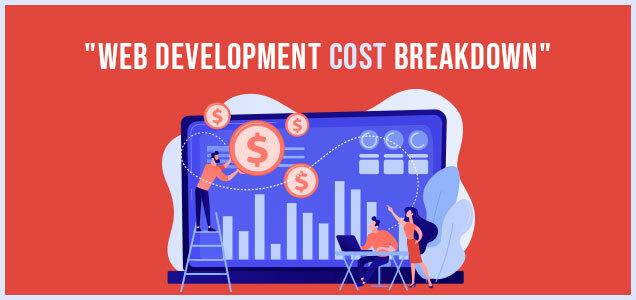
Website cost estimation might seem like nothing extraordinary, which is true to some extent, but it's not simple either. Even though we now have bigger, better digital platforms like mobile apps, SaaS, and AI products with never-ending complexities, it doesn’t mean websites are obsolete or don’t require serious budgeting.
A website can cost anywhere from $500 to $50,000—or even more. This huge variation in website cost is due to several factors, including your goal with the website, design depth, backend capabilities, modern eCommerce features, hosting needs, custom APIs, premium plugins, and other add-ons.
A basic website typically has four core cost pillars:
● Initial DIY Build: $50 - $500
● Professional Web Design & Development (optional): $2,000 or more
● Hosting & Apps: $20 - $150 (monthly)
● Maintenance & Upgrade: $100 - $250 (annually)
Since every business differs in nature and scale, the question “How much does a website cost?” has a different answer depending on the type and complexity of the project. Here’s a full breakdown of web development costs to help you set a clear yet lean budget with the right expectations.
Not all websites are the same, nor are their costs. Depending on the type of website you need, development complexity, integrations, and business use case, the web development cost can range significantly.
Below is a breakdown of the 10 most in-demand website types that businesses regularly pay professionals to build, along with practical use cases and average website cost estimates in the US.
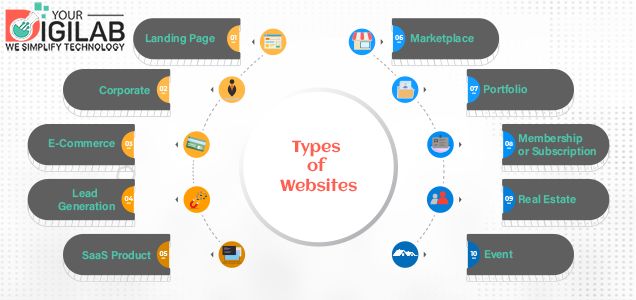
Use Case: Pre-launch promotions, app downloads, product teasers, lead generation, or event RSVPs.
Development Scope: One scrollable page built with a conversion-first layout. May include a contact form, hero section, testimonials, CTA buttons, and basic analytics integration. Usually static or semi-dynamic with minimal backend.
Tech Stack: HTML/CSS/JS, Bootstrap, or Tailwind UI. Optional: WordPress, Webflow, or React for advanced interactivity.
Avg Landing Page Website Cost: $500 – $2,000
DIY template: <$300 | Custom-coded: $1,500–$2,000
Use Case: Mid-to-large businesses wanting a professional, SEO-optimized online presence to showcase services, team, locations, and brand credibility.
Development Scope: 5–20+ pages, including service pages, blog, careers, contact, and legal pages. Needs responsive design, accessibility compliance, CMS integration (typically WordPress or headless CMS), and scalable architecture.
Tech Stack: WordPress, Webflow, or custom frontend (React/Vue) + CMS/backend.
Avg Corporate Website Cost: $5,000 – $25,000
Mid-size company: $7,000–$15,000 | Enterprise-level: $20,000+
Use Case: D2C brands, online stores, or retailers selling physical or digital products with checkout, inventory, and order management.
Development Scope: Product catalog, cart, checkout system, user accounts, payment gateways (Stripe, PayPal), shipping integrations, tax configuration, and backend dashboard.
Tech Stack: Shopify, WooCommerce, Magento, BigCommerce, or custom stack (React + Node + Stripe API).
Avg eCommerce Website Cost: $8,000 – $50,000+
Shopify/WooCommerce setup: $5,000–$15,000 | Custom-built store: $30,000+
Use Case: Service-based businesses like law firms, consultants, agencies, and contractors needing inbound client inquiries.
Development Scope: 5–10 pages with CTAs, quote/request forms, integrations with CRM (e.g., HubSpot, Salesforce), landing pages for ad traffic, and tracking tools (GA4, Hotjar, Tag Manager).
Tech Stack: WordPress, Webflow, or custom stack with backend form handling and API integrations.
Avg Lead-Gen Website Cost: $3,000 – $10,000
Basic site with forms: $3,000–$5,000 | CRM integrated + custom funnel: $8,000+
Use Case: Software products and platforms that need to drive signups, onboard users, and explain complex offerings.
Development Scope: Dynamic homepage, pricing page, blog, knowledge base, gated content, login portal integration, and high-converting UI with performance optimization. Must include responsive UX/UI, animation, and backend/API integration for lead capture and CRM sync.
Tech Stack: Next.js or React frontend + Headless CMS (e.g., Sanity, Contentful) + CI/CD for fast deployment.
Avg SaaS Website Cost: $10,000 – $40,000+
Startup MVP site: $10,000–$20,000 | Custom UI + onboarding flows: $30,000+
Know What You’ll Spend Before You Start
Get a clear estimate of your web development cost—no surprises, just real numbers.
Use Case: Platforms that connect buyers and sellers (e.g., job boards, rental platforms, freelance marketplaces).
Development Scope: Multi-vendor system with user registration, dashboards, product/service listings, chat/messaging, transaction handling, reviews, admin controls, and complex backend logic.
Tech Stack: MERN/MEAN stack or Laravel + Vue. Integrates with Stripe Connect, AWS, Firebase, and security layers.
Avg Marketplace Website Cost: $25,000 – $100,000+
MVP marketplace: $30,000–$50,000 | Full-scale with mobile support: $80,000+
Use Case: Creative professionals, consultants, and digital agencies needing a high-impact visual presence and credibility.
Development Scope: 3–8 custom-designed pages, dynamic case studies or projects, interactive elements (scroll effects, transitions), and mobile-first layout.
Tech Stack: WordPress, Webflow, or JAMstack (Gatsby/Next.js with headless CMS).
Avg Portfolio Website Cost: $1,500 – $7,000
Template-based: $1,500–$3,000 | Fully custom + animations: $5,000–$7,000
Use Case: Realtors, agencies, and brokers needing to showcase listings and generate buyer/seller leads.
Development Scope: Listing filters, map integration (Google Maps or Mapbox), property management backend, mortgage calculator, contact forms, IDX/MLS feed integration (where applicable).
Tech Stack: WordPress + IDX plugins, Laravel + custom backend, or React-based frontend with dynamic APIs.
Avg Real Estate Website Cost: $5,000 – $20,000
Small agency: $5,000–$10,000 | Nationwide or franchise: $15,000–$20,000
Use Case: Online communities, gated content hubs, online course platforms, or recurring content delivery businesses.
Development Scope: Member login, paywall integration, user profiles, tiered plans, subscription billing, content delivery system, and access control logic.
Tech Stack: WordPress (MemberPress, Restrict Content Pro), Laravel + Stripe API, or Node.js + Firebase for more scalable systems.
Avg Membership Website Cost: $7,000 – $30,000
Basic WordPress site: $7,000–$12,000 | Custom subscription logic: $20,000+
Use Case: Hosting in-person or virtual events, summits, trade shows, and seminars with speaker schedules and attendee registration.
Development Scope: Event schedule, ticketing system (Eventbrite or custom), speaker bios, RSVP/registration system, calendar integration, email automation, and real-time updates.
Tech Stack: WordPress + event plugins, React/Vue frontends, or custom backends with Stripe and mailing integrations.
Avg Cost (US): $3,000 – $15,000
Single event site: $3,000–$6,000 | Recurring conferences with ticketing: $10,000–$15,000
Let’s start the website cost breakdown in 2 main pillars that are the core of any website creation process: design and development.
Validate Your Website Idea First
Not sure if your concept will work? Start with a low-risk MVP.
Website design is not just about visual aesthetics — it’s about user experience (UX), user interface (UI), brand identity, and conversion-driven layout structuring. Whether you're building a simple business site or a conversion-focused eCommerce platform, web design cost will vary based on the depth, process, tools, and expertise involved.
This foundational stage includes competitor research, audience profiling, brand positioning, and sitemap planning. Designers often create mood boards and define user goals here to align the visual strategy.
Estimated Cost: $300 – $1,000
Wireframes map the basic structure and content layout of each page, ensuring a logical flow. Good UX design anticipates user behavior and makes the experience smooth across touchpoints.
Estimated Cost: $300 – $1,000
Here, designers translate UX into visual form—colours, typography, icon sets, and imagery. Prototypes simulate user interaction and provide a realistic preview of the interface.
Estimated Cost: $800 – $2,000
This ensures the design adapts across desktop, tablet, and mobile devices. It involves separate layout considerations, touch-target scaling, and testing on various screen resolutions.
Estimated Cost: $500 – $2,000
Custom branding includes logos, visual identity kits, typography, and icon libraries to maintain consistency across the website.
Estimated Cost: $300 – $1,500
This phase involves refining the design based on stakeholder feedback, accessibility tests, and final usability tweaks.
Estimated Cost: $200 – $500
Web Design Cost Breakdown (By Phases) |
||
Design Phase |
Description |
Estimated Cost |
|
Discovery & Planning |
Competitor research, target audience analysis, mood boards, and design strategy |
$300 – $1,000 |
|
Wireframing & UX Design |
Structural layout of web pages (low-fidelity) to define information hierarchy |
$300 – $1,000 |
|
UI Design & Prototyping |
High-fidelity visual design with colours, fonts, imagery, clickable prototypes |
$800 – $2,000 |
|
Responsive Design |
Adapting layout for desktop, tablet, mobile; often requires separate attention |
$500 – $2,000 |
|
Branding Integration |
Custom branding elements (logos, icons, typography systems) |
$300 – $1,500 |
|
Revisions & Testing |
Refining UI/UX based on feedback and user flows |
$200 – $500 |
The web design cost in the US ranges from $1,500 to $10,000+ for a professionally designed, UX-optimized layout tailored to your brand and user journey. For startups or small businesses, a basic template-based or freelance design solution may cost $500 to $1,500, depending on revisions, page count, and responsiveness.
The web development cost refers to the process of turning a design into a functional, secure, and scalable website. Development includes both frontend (what users interact with) and backend (server-side logic, databases, and infrastructure), along with optional CMS integration, third-party APIs, or full-stack solutions.
Frontend development covers HTML, CSS, and JavaScript to bring UI designs to life. It includes interactive components like sliders, modals, responsive grids, and animation handling.
Estimated Cost: $1,500 – $6,000
The backend is responsible for everything under the hood: server configuration, APIs, databases, user authentication, admin panels, and secure data flow.
Estimated Cost: $2,000 – $10,000+
This includes installing and customizing CMS platforms like WordPress, Shopify, or Webflow. It involves theme tweaks, plugin integration, and content population.
Estimated Cost: $1,000 – $5,000
This is a complete solution involving both frontend and backend development. It often includes DevOps tasks, third-party integrations, security layers, and cloud infrastructure setup.
Estimated Cost: $5,000 – $20,000+
Web Development Cost Breakdown (By Type) |
||
Development Type |
What It Includes |
Estimated Cost |
|
Frontend Development |
HTML/CSS/JS implementation of designs, responsive layouts, interactive components |
$1,500 – $6,000 |
|
Backend Development |
Server-side logic, database setup, APIs, admin panel, authentication |
$2,000 – $10,000+ |
|
CMS Development |
WordPress, Webflow, Shopify custom setup, theme development, content config |
$1,000 – $5,000 |
|
Full-Stack Development |
End-to-end solution covering both frontend and backend, DevOps, integration layers |
$5,000 – $20,000+ |
Web Development Cost Breakdown (By Phases) |
||
Phase |
Description |
Estimated Cost |
|
Environment Setup |
Code repositories, staging server, frameworks, cloud setup |
$300 – $800 |
|
Frontend Implementation |
Building the UI using React, Vue, HTML/CSS, animations, transitions |
$1,500 – $6,000 |
|
Backend Development |
Setting up logic, APIs, user roles, databases, payment gateways |
$2,000 – $8,000+ |
|
CMS Configuration |
Creating backend interface for non-technical editing (WordPress, Webflow, etc.) |
$1,000 – $4,000 |
|
Integrations |
External APIs, CRMs, live chat, analytics, email platforms |
$500 – $2,000 |
|
QA & Debugging |
Browser testing, load testing, device responsiveness |
$300 – $1,500 |
|
Deployment |
Final push to live server, DNS setup, SSL, backups |
$200 – $1,000 |
The average web development cost varies between $3,000 and $20,000+, based on your site’s complexity, required functionality, backend architecture, and integration needs. Advanced features like scalable APIs, eCommerce, or CMS development increase costs, while simple static websites or minimal CMS builds fall on the lower end of the range.
Not Sure What It’ll Cost You?
Get a custom breakdown based on your business goals, not vague averages.
Understanding what goes into the total cost of a website is essential to budgeting effectively. From UI design to backend architecture and third-party tools, each component has a cost implication. Below is a breakdown of the most relevant factors impacting the website development cost, including comparisons and real market insights to help you plan smart.
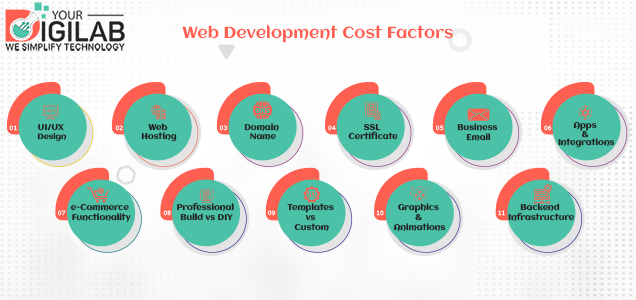
How much does it cost to design a website? This depends heavily on design complexity, brand personality, responsiveness, and custom visuals. Professional website design cost from scratch can range between $1,000 – $10,000+, depending on the number of templates, devices to support, and custom UX flows.
|
Design Type |
Average Cost |
Description |
|
DIY Template (e.g., Wix) |
$0 – $300 |
Suitable for basic portfolios or starter sites. Limited customisation. |
|
Freelance Designer |
$500 – $2,000 |
Depends on experience and deliverables (homepage, inner pages, UI kits). |
|
Agency Design Package |
$3,000 – $5,000+ |
Includes UX research, branding, responsiveness, and interaction design. |
|
Custom UI/UX (Enterprise) |
$5,000 – $10,000+ |
For high-conversion web apps, SaaS, or heavily branded B2B experiences. |
Beyond aesthetics, UX design plays a direct role in conversions and bounce rate. Poor design choices can turn away users even before they interact with your product. For industries like SaaS, marketplaces, or eCommerce, intuitive design isn't optional—it's part of the product experience.
Hosting determines how fast, reliable, and secure your website is. Choosing the right provider also affects scalability, backup, and ongoing costs. Hosting can range from $5/month - $500/month, depending on traffic load, infrastructure type (shared vs. VPS vs. dedicated), and managed services.
|
Hosting Provider |
Type |
Avg Monthly Cost |
Key Features |
|
Bluehost |
Shared/VPS |
$5 – $30 |
Easy setup, WordPress optimized |
|
SiteGround |
Shared/Cloud |
$15 – $100 |
Great for performance & security |
|
WP Engine |
Managed WP |
$25 – $250 |
Premium managed WordPress hosting |
|
DigitalOcean |
VPS/Cloud |
$6 – $120 |
Developer-friendly, flexible scaling |
|
AWS (Amazon Lightsail) |
Cloud |
$5 – $500+ |
Advanced scalability for enterprise use |
For business websites expecting spikes in traffic or eCommerce activity, opting for a cloud-based or managed hosting plan is worth the investment to avoid downtime or lag.
A domain name is your digital identity. Most .com domains cost $10 – $20/year, but premium domains (short, keyword-rich, or aged) can go for hundreds or even thousands.
|
Domain Provider |
Cost (per year) |
Renewal Price |
Features |
|
GoDaddy |
$10 – $15 |
$15 – $20 |
Add-on upsells, easy DNS mgmt |
|
Namecheap |
$8 – $12 |
$10 – $15 |
Affordable, privacy included |
|
Google Domains |
$12 |
$12 |
Clean UI, simple integration |
|
Cloudflare |
At-cost pricing |
No markup |
Excellent DNS, secure by default |
Always check renewal prices and avoid hidden costs like forced add-ons or SSL charges.
An SSL certificate is mandatory today—not just for security but also for SEO. Free options like Let’s Encrypt are suitable for basic websites. For eCommerce or financial platforms, a paid SSL (with insurance and trust seal) can cost $10 – $300/year.
● Basic SSL (Let’s Encrypt): Free
● Premium SSL (Sectigo, DigiCert): $70 – $300/year
● Wildcard or Multi-domain SSL: $150 – $500/year
SSL also directly influences customer trust—especially in checkout or data-entry pages.
Professional email addresses (e.g., contact@yourbusiness.com) add credibility. Providers like Google Workspace and Zoho offer bundled services:
● Google Workspace: $6 – $18/user/month
● Zoho Mail: Free – $4/user/month
● Microsoft 365: $6 – $12.50/user/month
Also consider integration with CRM or shared calendars to optimize operations.
Depending on your business goals, you’ll likely need third-party integrations—analytics, forms, CRM, payment gateways, live chat, etc. These come with their own setup and subscription costs:
● Basic integrations (Forms, Chat): Free – $30/month
● Advanced tools (CRMs, Email Marketing, Analytics): $30 – $300/month
● Custom API integrations: $500 – $5,000+ (one-time)
Make sure you're not overloading your stack with bloated or overlapping tools.
Selling online isn’t just about adding a "Buy Now" button. Functional eCommerce websites require product management systems, payment gateways, tax handling, shipping rules, and customer dashboards.
● Basic WooCommerce or Shopify setup: $2,000 – $6,000
● Custom eCommerce platform (Magento, custom stack): $8,000 – $50,000+
● Ongoing costs: Payment gateway fees (~2.9% + 30¢/transaction), inventory integrations, maintenance.
For retail, fashion, DTC, and subscription-based models, these features can significantly scale up both upfront and ongoing costs.
A drag-and-drop site builder like Wix or Squarespace may cost $10 – $50/month. But for real business use cases, such platforms can quickly fall short in scalability, security, SEO, and design control.
● DIY Site Builders: $200 – $500/year
● Freelancers: $1,500 – $5,000
● Professional agency build: $5,000 – $50,000+
Startups may begin with a DIY approach, but usually need a professional rebuild as they scale.
Templates save time and cost—but often limit flexibility and brand identity. Custom designs are built around your user journeys, products, and conversion goals.
● Premium templates: $30 – $300
● Template customization: $500 – $2,000
● Custom design (UI/UX + Development): $3,000 – $15,000+
A custom site pays off over time through performance, SEO, and differentiation.
Visual appeal can make or break your website. Custom illustrations, animations, video backgrounds, and SVG assets all impact both cost and load time.
● Stock visuals: $5 – $50
● Custom animations (Lottie, CSS, JS): $500 – $5,000
● Explainer or brand videos: $200 – $2,000+
If you’re targeting premium users or operating in a creative industry, visual polish is essential.
This is often the most expensive yet invisible part of a website. The backend supports databases, login systems, user flows, content management, and APIs. Choices here impact long-term scalability and performance.
● Monolithic CMS (WordPress, Joomla): Quick to deploy but less flexible
● Headless CMS (Contentful, Strapi): Great for multi-device and future-proof setups
● Cloud-native architecture (AWS, GCP, Azure): Best for high-traffic platforms
Costs range from $1,000 - $10,000+ for robust, scalable platforms with custom APIs, microservices, and dynamic data handling.
Confused About What You Need?
We’ll help you prioritize features and avoid unnecessary costs.
Building a website is just the beginning. Once your site is live, ongoing investment is required to keep it secure, high-performing, and aligned with business goals. From performance tracking and SEO to content updates and legal compliance, these post-launch activities ensure your website continues to deliver value long after the development phase.
Launching a website is only the beginning—keeping it secure, up-to-date, and error-free is a continuous process that significantly affects long-term cost and performance. Website maintenance includes everything from routine software updates to security patches, performance monitoring, uptime management, bug fixes, and adding new features as your business evolves.
● Basic website (static or brochure-style): $30 – $100/month
● CMS-based site with moderate traffic: $100 – $400/month
● eCommerce or enterprise-grade site: $500 – $2,500+/month
(Includes 24/7 monitoring, backups, performance tuning, incident response)
Search Engine Optimization (SEO) isn’t a one-time activity—it’s an ongoing, deeply technical process that directly influences how your website ranks, loads, and performs across devices and geographies. It starts during development and continues indefinitely after launch.
● Basic SEO setup (during development): $300 – $1,500 (one-time)
● Ongoing technical SEO retainer: $500 – $2,000+/month (depending on site scale)
● Full SEO & content strategy (with technical + content + backlinks): $2,500 – 5,000/month+
Once your site is live, performance needs to be tracked through tools like Google Analytics 4 (GA4), Tag Manager, Hotjar, and custom event-based tracking. Conversion Rate Optimization (CRO) involves heatmaps, A/B testing, funnel analysis, and behavior tracking to fine-tune how users interact with your site.
● Basic analytics setup: $100 – $500 (one-time)
● Advanced CRO tools & integration: $500 – $2,000+
● Ongoing CRO/UX optimization retainers: $1,000 – $3,000/month
Websites—especially those operating in regulated industries or targeting users in the EU/UK/California—need to comply with data privacy regulations such as GDPR, CCPA, or ADA accessibility requirements.
● Cookie/GDPR compliance tools: $10 – $100/month
● Legal document setup (via lawyer or legal tech): $300 – $1,500+
● Full ADA compliance audit & implementation: $1,000 – $3,000+
Effective website cost optimization is about aligning budget with business goals, not cutting corners. Every decision—from choosing a platform to how you structure the development team—affects your total spend. Below are 5 actionable strategies to help you optimize web development cost while maintaining quality, scalability, and business value.
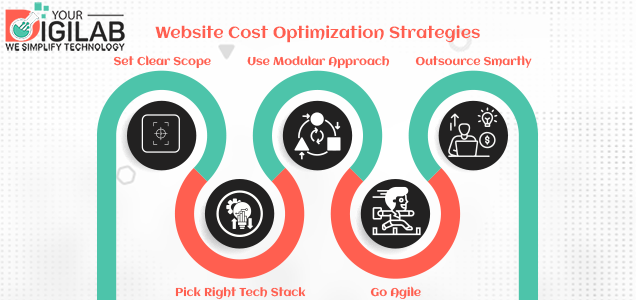
Before hiring anyone or buying any tools, create a clear, prioritized list of features and goals. Separate “must-haves” from “nice-to-haves.” This reduces development hours, minimizes scope creep, and helps avoid paying for unused functionality. Use low-fidelity wireframes or flowcharts to visualize user journeys before development begins.
Tech stack decisions (e.g., WordPress vs. headless CMS, custom frontend vs. template-based) affect both upfront development cost and long-term scalability. For startups, choosing modern but resource-efficient stacks like Webflow, Nuxt, or Firebase can help speed up delivery without sacrificing performance. Avoid over-engineered stacks for basic use cases.
Break your site into components (header, pricing table, product grid, etc.) and design/develop each modularly. This allows reusability across pages, lowers design and coding effort, and simplifies future updates. Modular builds also support better version control and performance optimization.
Instead of one massive build, split your project into clear sprints or milestones (e.g., UI mockups, frontend build, backend API integration, testing). This allows you to track progress, pivot if needed, and only pay when key deliverables are met. Agile workflows reduce rework and lead to cleaner handoffs.
Outsource complex components (e.g., payment integration, custom dashboard, SEO optimization) while handling low-risk tasks like content population or product uploads in-house. You can also use no-code tools for admin dashboards or forms to reduce custom backend cost. Strategic outsourcing helps optimize both budget and delivery speed.
Avoid Overpaying for Underbuilt Websites
Find out what’s fair and what’s inflated before hiring a developer.
Understanding your hiring model is the foundation of cost control. The most common options include:
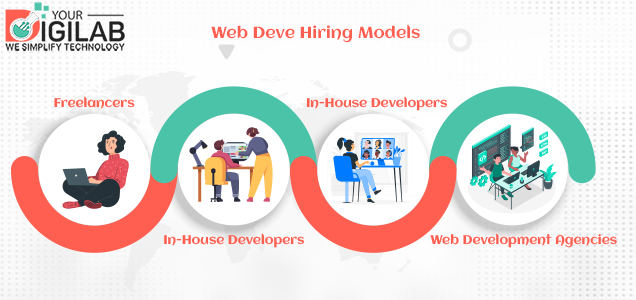
Ideal for simple websites or quick MVPs. Freelancers typically charge $25–$100/hour, and while this can be budget-friendly, it often lacks project continuity, scalability, and post-launch support.
Suitable for tech-driven startups with continuous development needs. While offering full control, the average salary of a US-based developer is $80,000–$120,000/year, which makes this model capital-intensive.
Popular for scaleups needing flexibility and control without local hiring overheads. You get vetted professionals at global rates ($2,000–$7,000/month depending on role), ideal for long-term builds.
Best for full-scale or high-stakes projects with defined goals, tight deadlines, or broader UX, branding, and compliance requirements.
|
Hiring Model |
Avg Cost |
Best For |
|
Freelancers |
$25 – $100/hour |
Small websites, short-term tasks |
|
In-House Developers |
$60,000 – $100,000/year |
Product-driven startups, internal tools |
|
Remote Dedicated Teams |
$2,000 – $7,000/month (per dev) |
Long-term, scalable projects |
|
Agencies |
$5,000 – $30,000+ per project |
Full-scale or high-stakes websites |
|
DIY Website Builders |
$10 – $50/month |
MVPs, temporary pages |
There’s no one-size-fits-all pricing for web development because each project varies by scope, complexity, tech requirements, and team size. However, understanding the core website cost formula behind most structures help estimate project budget realistically.
Total Web Development Cost = Design + Development + Tech Stack + Hosting & Domain + Integrations + Maintenance + Post-Launch Services
This website cost formula breaks your website project into logical parts—design, development, infrastructure, and post-launch needs—making it easier to evaluate cost based on your scope, goals, and feature requirements. It’s ideal when working with agencies or service providers offering packaged services or phase-based pricing.
Use this method when you have a defined list of features or are seeking a fixed-cost proposal.
Hourly Rate × Development Time
Total Web Development Cost = Hourly Rate × Estimated Development Hours
This is the go-to website cost formula for freelance developers, agile teams, or retainer-based contracts. Estimate development time based on your desired features, level of customisation, and complexity. Hourly rates vary based on geography, expertise, and project type:
|
Developer Type |
US Hourly Rate (Avg.) |
|
Freelance Developer |
$30 – $60/hr |
|
Mid-Tier Development Firm |
$80 – $120/hr |
|
Top-Tier Agency |
$150 – $200+/hr |
To estimate total website cost using this formula, multiply the average rate by the total number of hours project is expected to take. For example, a 200-hour project at $100/hour results in a $20,000 budget. Use this method for agile, milestone-driven builds or long-term development engagements.
Hiring a web design and development company is not always necessary—but it becomes critical when your website is a revenue channel, core business asset, or brand-defining product. Agencies bring structured processes, access to multi-disciplinary teams, accountability, and technical consistency. For businesses that need custom development, branding, SEO, UX/UI, and scalability, working with an agency is often more cost-efficient in the long run than patching together freelance help.
● You need a custom website with eCommerce, integrations, or CMS features
● Your internal team lacks technical leadership or design capabilities
● You require post-launch services like SEO, performance monitoring, or maintenance
● You have compliance, accessibility, or scalability goals (HIPAA, WCAG, GDPR, etc.)
● Confirm deliverables, timelines, and support scope before signing
● Ask for recent work on similar industries or tech stacks
● Choose a partner offering lean, modular services—not bloated packages
● Ensure source code and assets are included in the handover
Working with the wrong agency, or unclear project specs, can cause scope creep and unexpected cost escalations. The right partnership, however, accelerates delivery and improves long-term ROI.
The cost of building a website isn’t just about design or development—it’s about making the right strategic moves at every phase. Whether you're a startup with limited resources or a growing business scaling fast, the right web development company helps you invest smart, not just spend.
At YourDigiLab, we don’t just code—we architect custom digital experiences that perform. From UX design to full-stack engineering, our team helps businesses build faster, launch stronger, and scale smarter.
From Local Business to Global Reach
Whether you’re a small business or a scaling brand, we’ve got your back.
Depending on complexity, expect to invest $5,000 to $25,000+ for a professionally designed and developed business website. Factors like eCommerce, third-party integrations, and custom CMS features push costs higher.
In theory, yes—if you already have developers. But without a senior technical lead and product manager, in-house builds can become unstructured, buggy, and expensive over time. It’s often cheaper and faster to hire a specialized team for fixed-scope builds.
DIY platforms like Wix or Squarespace are fine for temporary or MVP pages but come with platform limitations, limited SEO control, and fewer customization options. They’re not suited for serious business websites.
Choose a scalable CMS (like WordPress or Webflow), optimize performance from the start, and avoid unnecessary plugins. Investing in clean code and smart architecture upfront saves money later.
Create a clear scope document, define user flows and required features, and avoid adding features mid-development without impact analysis. Use agile sprints and milestone reviews to stay on track.
Web development in the US costs between $3,000 and $25,000+, based on complexity, features, and tech stack. Simple sites cost less; custom platforms with APIs, dashboards, or eCommerce cost more. Get a clear scope to avoid overpaying.
Professional web design costs range from $2,000 to $10,000+. This includes UX, UI, branding, and responsive layout. Basic freelance or template designs cost around $500 to $1,500, but often lack scalability and user experience depth.
Hire a web development company with a strong portfolio, proven backend and frontend skills, and experience in your industry. Make sure they offer transparent pricing, a structured development process, and ongoing support. A reliable web development company should also guide you on tech stack, scalability, and cost control—not just deliver code.
Ramsha is a talented writer known for top-quality content on trending topics. Her excellence in research enables her to add value to businesses by driving online traffic with engaging and persuasive content.